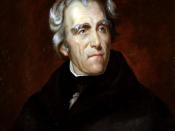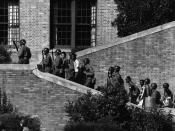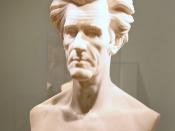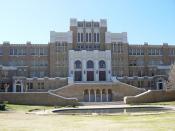In 1956, when Eisenhower decided to send troops into Little Rock, Arkansas, it was very similar to when Jackson had to decide to send troops into South Carolina. In 1832, President Andrew Jackson signed a tariff bill that favored the industrial north. South Carolina did not like this because, in their view, all the benefits of protection were going to northern manufacturers and while the country, as a whole grew richer, South Carolina grew poorer, with its planters bearing the burden of higher prices. People in South Carolina organized a "ÃÂStates Right Party'. . They declared the tariff null and void. They also threatened to secede if the federal government tried to collect the tariff. On December 10,1832 Jackson ordered troops and warships to be sent to Charleston. He felt that the action by South Carolina to refuse to pay the tariff was treason. A senator, Henry Clay, got another tariff passed that reduced other tariffs gradually, and, eventually, the conflict over tariffs died down and South Carolina remained in the Union.
In 1957, after the supreme Courts Brown vs. Board of Education decision, the school board in Little Rock, Arkansas accepted the fact that it would have to integrate schools. They started with Central High School. The first year of their integration plan, they planned on admitting seventeen students, but it later fell to only nine. Several times, the people of Little Rock, and even the governor tried to block the students from attending The first day, the governor, Orval Faubus had the school surrounded by national Guard who were instructed to not let the nine black students into the school. There was a mob in the streets that threatened to lynch the one girl who attempted to go to school. Lawyers from the NAACP got a court order from the Supreme Court that said the governor could not block them from attending school, and the nine students went. But they had to be escorted out halfway through the day because of mobs outside the school who were threatening them. President Eisenhower had to send in the 101st Airborne Division into Little Rock to ensure that the nine students could attend school. They stood guard outside the school, and each student had his own guard that protected him from the other students.
These two situations are alike because they both deal with a state trying to change a decision that was made by the national government. A tariff law in 1832 and a Supreme Court decision in 1957. Also, both times, the state was warned by the national government, but neither state listened. Both times however, the state did not succeed. The national government was able to regain their power but only through force.
Works Cited "Andrew Jackson"ÃÂ North Carolina Encyclopedia. [Accessed 29 November, 2001] "Jackson a Strong President"ÃÂ Outline of American History. [Accessed 29 November 2001]




